The automotive market today offers a plethora of options, particularly in the hybrid and SUV segments. The Ford Puma and Mazda 2 Hybrid provide intriguing alternatives for drivers looking for efficiency, performance, and practicality. This article compares these two models, highlighting their technical specifications and innovations. Let's dive deeper into what each vehicle brings to the table.
Ford Puma vs Mazda 2 Hybrid – Which car suits you better?
Both models have their strengths – but which one suits you more?
Compare performance, efficiency, price and space directly: Ford Puma or Mazda 2 Hybrid?
Design and Dimensions
The Ford Puma is designed as a compact SUV, exuding an athletic stance with its bold lines and modern aesthetics. Measuring approximately 4186 mm in length, 1805 mm in width, and standing at 1550 mm tall, it offers a spacious interior perfect for city driving and longer journeys alike. With a trunk capacity ranging from 456 to 523 liters, the Puma is well-equipped to handle shopping trips or weekend getaways.
On the other hand, the Mazda 2 Hybrid adopts a more traditional hatchback form, measuring 3940 mm in length and 1745 mm in width. Its compact dimensions make it an ideal choice for urban environments, promising ease of parking and maneuverability. While its trunk capacity of 286 liters is smaller than the Puma's, it still offers sufficient space for everyday use.
Engine and Performance
Under the hood, the Ford Puma features a versatile lineup of engines, including petrol MHEV (Mild Hybrid Electric Vehicle) options. With power outputs ranging from 125 to 168 HP, the Puma excels in performance, accelerating from 0 to 100 km/h in as little as 7.4 seconds, depending on the engine variant. The vehicle also boasts a top speed of up to 210 km/h, making it a spirited performer on highways.
In comparison, the Mazda 2 Hybrid relies on a full hybrid engine, producing 116 HP from its 1490 cm3 engine capacity. It sprints from 0 to 100 km/h in about 9.7 seconds, slightly slower than the Puma but still competitive for its class. The Mazda 2's max speed caps at 175 km/h, which may appeal to drivers looking for a combination of efficiency and adequate performance.
Fuel Efficiency
One of the standout features of both vehicles is their fuel efficiency. The Ford Puma achieves a consumption of between 5.4 to 6 L/100 km, depending on the engine variant. For hybrid models, the electric range can reach up to 376 km, complemented by a robust battery capacity of 43 kWh. This hybrid technology allows for reduced emissions and better fuel economy, aligning with eco-conscious driver preferences.
In contrast, the Mazda 2 Hybrid shines in this department, with a frugal consumption rating of approximately 3.8 to 4 L/100 km. This efficient powertrain also results in low CO2 emissions, ranging from 87 to 93 g/km. Mazda's commitment to sustainability is clear here, as the 2 Hybrid caters to a market increasingly focused on reducing their carbon footprint.
Interior and Technology
The interior of the Ford Puma combines practicality and style. With seating for five and a user-friendly layout, it caters to both drivers and passengers beautifully. A key highlight is the advanced infotainment system, which includes smartphone integration, allowing for seamless connectivity on the go. Additionally, the innovative use of space such as the MegaBox feature – a hidden storage compartment in the trunk – sets the Puma apart in its class.
Meanwhile, the Mazda 2 Hybrid's cabin is known for its driver-centric design and high-quality materials. The layout is intuitive, with an emphasis on ergonomics and comfort. Though the technological offerings are slightly less extensive than those of the Puma, the Mazda still features a competent infotainment system with modern connectivity options, further enhancing the driving experience.
Conclusion
In conclusion, the choice between the Ford Puma and Mazda 2 Hybrid ultimately comes down to personal preferences and priorities. The Puma excels in space, performance, and hybrid technology while providing ample practicality for families. Alternatively, the Mazda 2 Hybrid stands out for its exceptional fuel efficiency and compact nature, making it an ideal choice for urban dwellers.
Both vehicles represent their brands well, embodying the spirit of sustainable driving without compromising on performance and comfort. As the automotive landscape continues to evolve, the Ford Puma and Mazda 2 Hybrid are excellent examples of how innovation can meet the needs of today’s drivers.
Here’s where it gets real: The technical differences in detail
Costs and Efficiency:
Price and efficiency are key factors when choosing a car – and this is often where the real differences emerge.
Mazda 2 Hybrid has a to a small extent advantage in terms of price – it starts at 21400 £, while the Ford Puma costs 24800 £. That’s a price difference of around 3351 £.
Fuel consumption also shows a difference: Mazda 2 Hybrid manages with 3.80 L and is therefore significantly more efficient than the Ford Puma with 5.40 L. The difference is about 1.60 L per 100 km.
Engine and Performance:
Power, torque and acceleration say a lot about how a car feels on the road. This is where you see which model delivers more driving dynamics.
When it comes to engine power, the Ford Puma has a evident edge – offering 168 HP compared to 116 HP. That’s roughly 52 HP more horsepower.
In acceleration from 0 to 100 km/h, the Ford Puma is distinct quicker – completing the sprint in 7.40 s, while the Mazda 2 Hybrid takes 9.70 s. That’s about 2.30 s faster.
In terms of top speed, the Ford Puma performs to a small extent better – reaching 210 km/h, while the Mazda 2 Hybrid tops out at 175 km/h. The difference is around 35 km/h.
Space and Everyday Use:
Cabin size, boot volume and payload all play a role in everyday practicality. Here, comfort and flexibility make the difference.
Both vehicles offer seating for 5 people.
In curb weight, Mazda 2 Hybrid is to a small extent lighter – 1180 kg compared to 1316 kg. The difference is around 136 kg.
In terms of boot space, the Ford Puma offers significantly more room – 523 L compared to 286 L. That’s a difference of about 237 L.
In maximum load capacity, the Ford Puma performs noticeable better – up to 1283 L, which is about 348 L more than the Mazda 2 Hybrid.
When it comes to payload, Ford Puma slight takes the win – 469 kg compared to 435 kg. That’s a difference of about 34 kg.
Who comes out on top?
Overall, the Ford Puma shows itself to be dominates this comparison and secures the title of DriveDuel Champion.
It convinces with the more balanced overall package and proves to be the more versatile choice for everyday use.
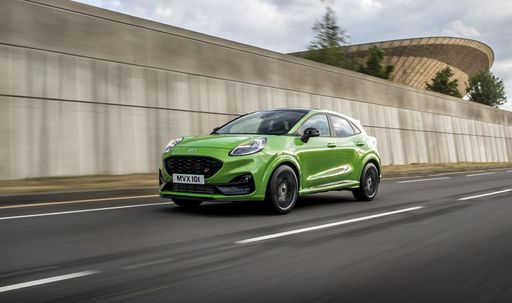 @ Ford Motor Company / Ford Media Center
@ Ford Motor Company / Ford Media Center
Ford Puma
Ford Puma
The Ford Puma is a cheeky compact crossover that blends sporty styling with city-friendly practicality, giving drivers a surprisingly fun and composed ride. With clever storage tricks and a lively personality, it’s a smart pick for buyers who want enjoyment without fuss.
details @ Ford Motor Company / Ford Media Center
@ Ford Motor Company / Ford Media Center
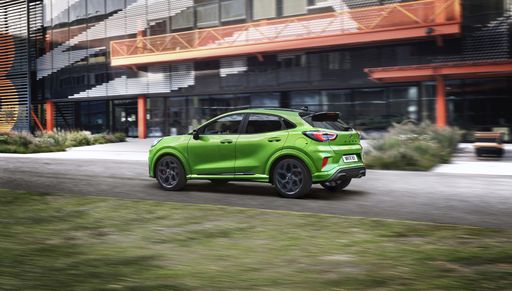 @ Ford Motor Company / Ford Media Center
@ Ford Motor Company / Ford Media Center
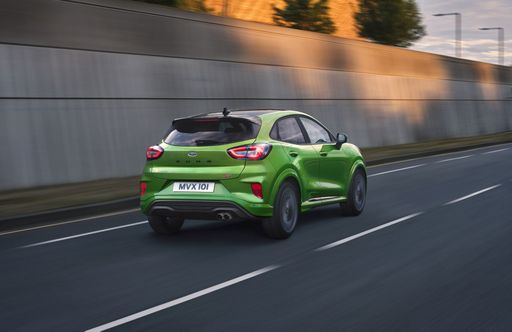 @ Ford Motor Company / Ford Media Center
@ Ford Motor Company / Ford Media Center
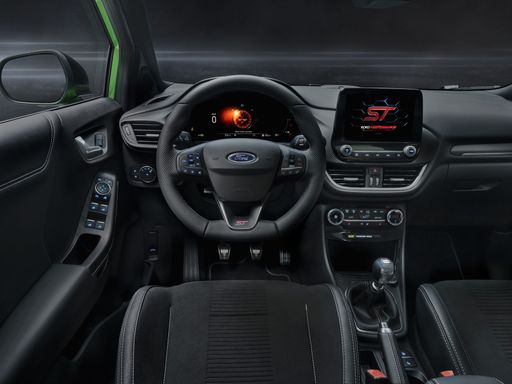 @ Ford Motor Company / Ford Media Center
@ Ford Motor Company / Ford Media Center
Mazda 2 Hybrid
The Mazda 2 Hybrid impresses with its sleek design and advanced hybrid technology, making it a strong contender in the compact car category. It offers a refined driving experience with smooth transitions between electric and petrol power, ensuring both efficiency and performance. Inside, the cabin is thoughtfully designed, providing comfort and intuitive controls for a modern driving experience.
details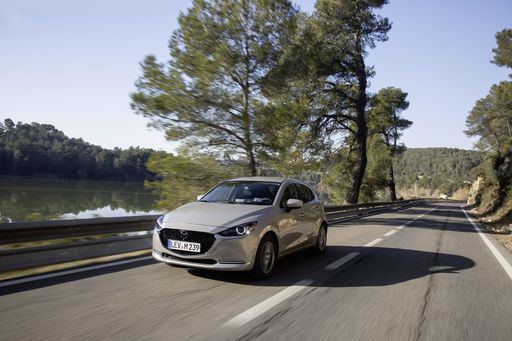 @ Mazda Motor Corporation
@ Mazda Motor Corporation
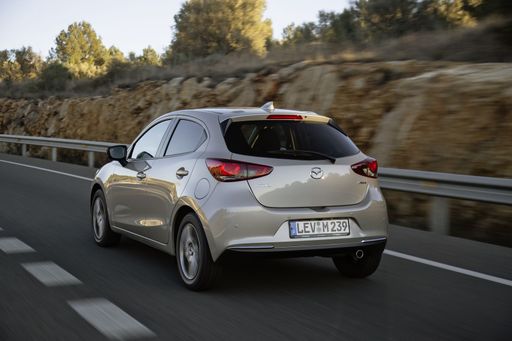 @ Mazda Motor Corporation
@ Mazda Motor Corporation
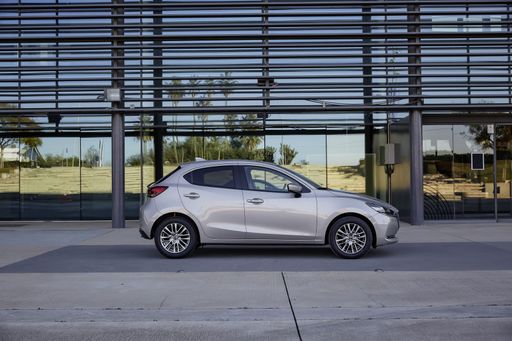 @ Mazda Motor Corporation
@ Mazda Motor Corporation
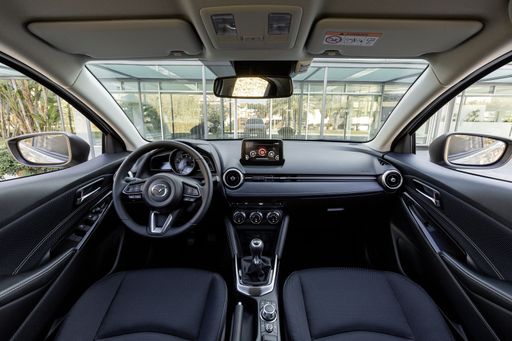 @ Mazda Motor Corporation
@ Mazda Motor Corporation
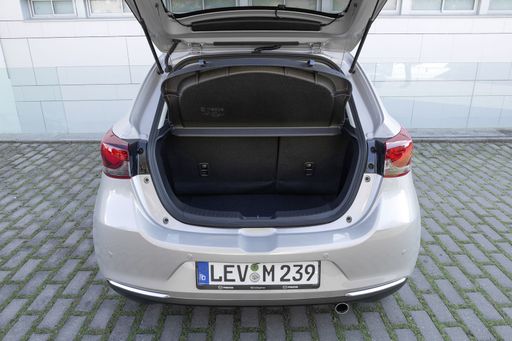 @ Mazda Motor Corporation
@ Mazda Motor Corporation
 @ Ford Motor Company / Ford Media Center
@ Ford Motor Company / Ford Media Center
|
 @ Mazda Motor Corporation
@ Mazda Motor Corporation
|
|
|
|
Costs and Consumption |
|
|---|---|
|
Price
24800 - 36300 £
|
Price
21400 - 28200 £
|
|
Consumption L/100km
5.4 - 5.9 L
|
Consumption L/100km
3.8 - 4 L
|
|
Consumption kWh/100km
13.1 - 13.9 kWh
|
Consumption kWh/100km
-
|
|
Electric Range
361 - 376 km
|
Electric Range
-
|
|
Battery Capacity
43 kWh
|
Battery Capacity
-
|
|
co2
0 - 135 g/km
|
co2
87 - 93 g/km
|
|
Fuel tank capacity
42 L
|
Fuel tank capacity
36 L
|
Dimensions and Body |
|
|---|---|
|
Body Type
SUV
|
Body Type
Hatchback
|
|
Seats
5
|
Seats
5
|
|
Doors
5
|
Doors
5
|
|
Curb weight
1316 - 1563 kg
|
Curb weight
1180 kg
|
|
Trunk capacity
456 - 523 L
|
Trunk capacity
286 L
|
|
Length
4186 - 4226 mm
|
Length
3940 mm
|
|
Width
1805 mm
|
Width
1745 mm
|
|
Height
1550 - 1555 mm
|
Height
1505 mm
|
|
Max trunk capacity
1216 - 1283 L
|
Max trunk capacity
935 L
|
|
Payload
367 - 469 kg
|
Payload
435 kg
|
Engine and Performance |
|
|---|---|
|
Engine Type
Electric, Petrol MHEV
|
Engine Type
Full Hybrid
|
|
Transmission
Automatic, Manuel
|
Transmission
Automatic
|
|
Transmission Detail
Reduction Gearbox, Manual Gearbox, Dual-Clutch Automatic
|
Transmission Detail
CVT
|
|
Drive Type
Front-Wheel Drive
|
Drive Type
Front-Wheel Drive
|
|
Power HP
125 - 168 HP
|
Power HP
116 HP
|
|
Acceleration 0-100km/h
7.4 - 9.8 s
|
Acceleration 0-100km/h
9.70 s
|
|
Max Speed
160 - 210 km/h
|
Max Speed
175 km/h
|
|
Torque
170 - 290 Nm
|
Torque
-
|
|
Number of Cylinders
3
|
Number of Cylinders
3
|
|
Power kW
92 - 124 kW
|
Power kW
85 kW
|
|
Engine capacity
999 cm3
|
Engine capacity
1490 cm3
|
General |
|
|---|---|
|
Model Year
2025
|
Model Year
2025
|
|
CO2 Efficiency Class
A, D
|
CO2 Efficiency Class
B
|
|
Brand
Ford
|
Brand
Mazda
|
Is the Ford Puma offered with different drivetrains?
The Ford Puma is offered with Front-Wheel Drive.
The prices and data displayed are estimates based on German list prices and may vary by country. This information is not legally binding.
